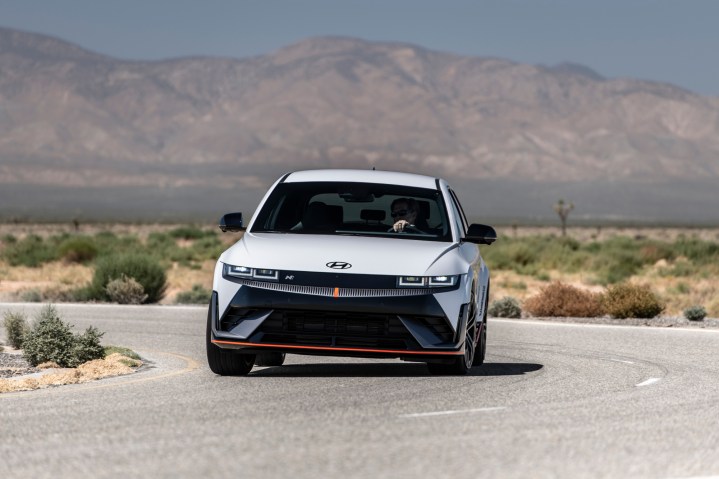The Hyundai Ioniq 5 is getting even more powerful. Hyundai has unveiled a new variant of the now-loved EV, giving it the classic N treatment — and making for the new Hyundai Ioniq 5 N.
If you’re familiar with Hyundai’s N cars, you’ll know what this variant means. The new car boasts racing-style accents, turns the pixel design up to eleven, and, as you would expect, offers a new powertrain and a range of performance-focused features that will make driving the new Ioniq 5 N a whole lot more fun.
IONIQ 5 N was developed to take driving fun to a new level by utilizing the latest technologies available,” said Till Wartenberg, vice president and head of N Brand and Motorsport at Hyundai Motor Company. “Starting with IONIQ 5 N, N brand aims to deliver its signature fun driving experience regardless of petrol, electric or hydrogen. To accomplish this, we’ve closely monitored the voices of our N fans in order to fine-tune our first all-electric N with the goal of electrifying the driving passion of our most demanding N-thusiasts.”

First, the styling. The car offers N branding throughout, including on the steering wheel, seats, and metal pedals. The steering wheel itself has N buttons that allow drivers to shift between N drive modes, and the modes themselves can be customized to be more easily accessible through the N buttons on the wheel. The center console is built with knee pads for more comfortable track driving and cornering.
Hyundai is quick to note that the car boasts a range of technical improvements over previous iterations of the Ioniq 5. For example, the car offers a new 84kWh battery with a two-stage inverter that enables up to a whopping 641 horsepower — with the N Grin Boost, which delivers maximum power to the wheels for 10 seconds, engaged.

Hyundai typically bills its N cars as being built for the track. The car is reinforced in an effort to better support track driving, with 42 additional welding points, and 6.9 feet of added structural adhesives. And, the steering system was strengthened in an effort to improve rigidity, helping improve overall steering response. According to Hyundai, the Ioniq 5 N offers a quicker steering ratio. This should make for a more nuanced steering experience overall.
Because of the fact that Hyundai had to counteract the weight of an electric car to deliver a sporty driving experience, it built the new N Pedal system, which adds an additional layer of regenerative braking that can help make for sharper cornering when coupled with more aggressive steering.

The Ioniq 5 N is built for drifting too. It has a new N Drift Optimizer feature that is aimed at taking in the multiple inputs of the car and simulating the feel of drifting on a combustion engine car. According to Hyundai, the N Drift Optimizer reacts in milliseconds, so the feel of drifting the Ioniq 5 N should be more or less the same as other cars.
While the Hyundai Ioniq 5 N is clearly a cool car, it’s definitely not for most people. The base Ioniq 5 certainly is one of the better EVs for most people — but most drivers that aren’t performance-minded should consider one of the entry-level models instead. Still, that’s not to take away from the Ioniq 5 N — and it’s nice to see that Hyundai is continuing the tradition with its electric cars.
Editors' Recommendations
- Don’t let the gimmicks fool you. The Ioniq 5 N is a serious track car
- Big EVs are almost here: 7 upcoming electric SUVs we’re excited for
- Hyundai Ioniq 6 first drive review: welcome to the future
- Hyundai Ioniq 5 first drive review: Retro modern
- See inside Amazon’s new EV trucks, now making deliveries in Los Angeles


